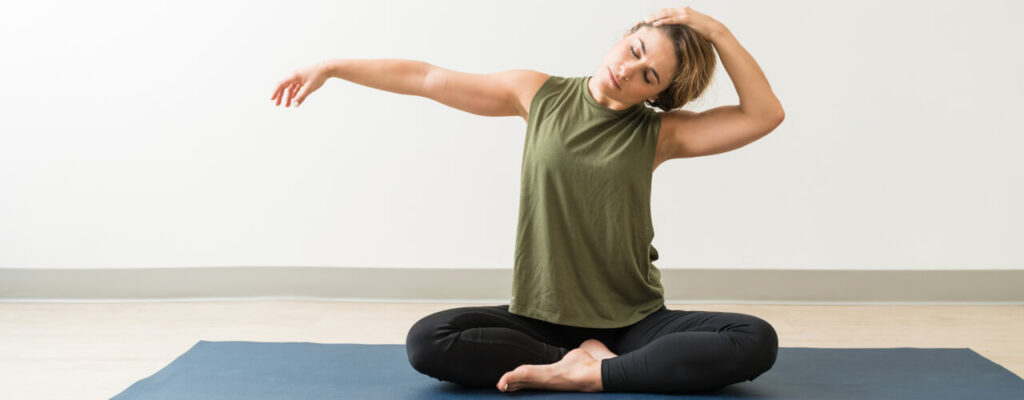The Importance of Stretching Before & After Exercise

Do you frequently choose to skip stretching after exercise?
It may be tempting to collapse on the couch after a good workout. Your workout, on the other hand, isn’t quite done. A proper cool down is required, which would include various types of stretching.
Some people believe that stretching is an unnecessary component of exercise. Stretching is, in fact, an essential component of exercise.
Can simple physical movements improve your overall health, wellness, and quality of life? In the case of stretching, the answer is unequivocally yes. Stretching exercises are an important part of physiotherapy for this reason.
If you haven’t been stretching after a workout, you may be experiencing muscle and joint pain.
You may be unaware of the best stretches to do after a workout. Please contact Lake Country Physiotherapy in Orillia, ON for information on how to stretch properly after exercise.
6 reasons to stretch after exercise
Six specific reasons why you should not skip stretching after exercising include:
- Lactic acid reduction – When you exercise, your body produces lactic acid, which contributes to sore, achy muscles. Stretching can help reduce lactic acid buildup throughout the body. It also helps to relax tense muscles.
- Improving heart function – Exercise increases blood flow, which has numerous health benefits. It is, however, equally important to return your heart rate to normal after the workout. Correct stretching will assist your heart in returning to a normal rate in a healthy manner.
- Avoiding muscle and joint strain – Proper stretching can reduce strain on your muscles and joints. It will assist your muscles in remaining flexible and toned. This will ultimately reduce the likelihood of injury following exercise.
- Improved range of motion – A personalized stretching routine that addresses your specific areas of postural imbalances and tightness can help you improve your range of motion. When you combine this with strength training and aerobic conditioning, you can expect to function more efficiently during your workouts and enjoy greater stamina, power, and speed.
- Relieving stress – Stretching regularly—especially when combined with deep breathing and mindfulness exercises—is a great way to ease mental stress and even reduce signs and symptoms of depression and anxiety.
- Reducing injury risk – Some studies do show that stretching may reduce your risk of muscle strains, ligament sprains, joint damage, and other painful injuries common with sports and athletics.
What are the consequences of not stretching?
If your muscles aren’t aching or sore after a workout, you may not feel the need to stretch. You might simply not want to put in the effort.
However, there are several potential consequences of failing to stretch properly after exercise. If you don’t stretch enough, you may experience stiffness.
Muscles and tendons that are not properly stretched after exercise may be more prone to injury. The Mayo Clinic recommends modifying your stretching routine if you already have an injury.
It’s also critical to ensure that you’re stretching after exercise and that you’re stretching correctly.
What is the connection between stretching and physiotherapy?
Stretching is usually done with connective tissue, a muscle, or a tendon. Stretching is used to increase range of motion, flexibility, and muscle elasticity. The following are the five most common stretching exercises:
- Proprioceptive Neuromuscular Facilitation (PNF)
- Dynamic
- Ballistic
- Static
- Low Load
A physiotherapist can teach you different stretching techniques that are more effective. Stretching, according to Move Forward, is an important part of exercise recovery, but it rarely gets the attention or time it deserves.
A physiotherapy program tailored to your specific needs can teach you how to stretch properly after exercise. Whether you’re a regular athlete or just getting in some exercise, a trained physiotherapist can teach you the best stretching techniques.
Stretching after exercise can help maintain the health of your muscles and joints. It is critical to locate a qualified physiotherapist who can teach you a variety of stretches.
If you’re experiencing muscle and joint pain as a result of a lack of stretching, seeing a physiotherapist may be beneficial. Stretching exercises taught by a therapist can improve your flexibility, reduce injuries, and even improve your athletic performance.
Physiotherapy and better health
Stretching has numerous advantages for helping your body stay healthy. One of the most important is stress reduction. Everyday life presents numerous challenges, and the resulting stress can be stored in your muscles.
Tightness, spasms, and chronic discomforts such as headaches and neck pain result. Stress also causes your body to release “fight or flight” hormones like cortisol and adrenaline. These imbalances can weaken your immune system, making you more susceptible to viruses and other diseases. Another dangerous side effect of chronic stress is hypertension.
Stretching on a regular basis allows your body to release pent-up stress. By relaxing and loosening your muscles, you can keep your blood pressure under control, avoid chronic muscle pain, and keep your immune system prepared for anything.
For more information, please contact Lake Country Physiotherapy
Contact our Orillia, ON clinic today to request an appointment and find out how we can assist you in developing the best stretching routine for your fitness level.
- https://www.mayoclinic.org/healthy-lifestyle/fitness/in-depth/stretching/art-20047931
- https://www.moveforwardpt.com/resources/detail/tips-to-recover-from-workout
